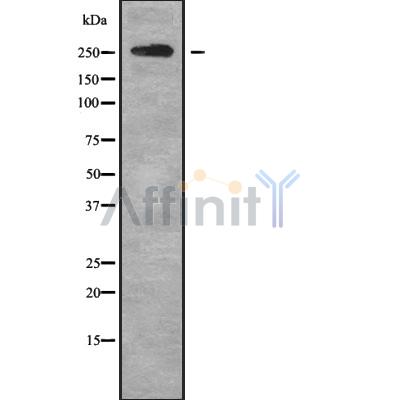ABCA4 Antibody - #DF9852
| Product: | ABCA4 Antibody |
| Catalog: | DF9852 |
| Description: | Rabbit polyclonal antibody to ABCA4 |
| Application: | WB IHC IF/ICC |
| Reactivity: | Human, Mouse |
| Prediction: | Pig, Bovine, Horse, Sheep, Rabbit, Dog |
| Mol.Wt.: | 256 kDa; 256kD(Calculated). |
| Uniprot: | P78363 |
| RRID: | AB_2843046 |
Product Info
*The optimal dilutions should be determined by the end user. For optimal experimental results, antibody reuse is not recommended.
*Tips:
WB: For western blot detection of denatured protein samples. IHC: For immunohistochemical detection of paraffin sections (IHC-p) or frozen sections (IHC-f) of tissue samples. IF/ICC: For immunofluorescence detection of cell samples. ELISA(peptide): For ELISA detection of antigenic peptide.
Cite Format: Affinity Biosciences Cat# DF9852, RRID:AB_2843046.
Fold/Unfold
ABC 10; ABC A4; ABC transporter, retinal-specific; ABC10; ABCA 4; abcA4; ABCA4_HUMAN; ABCR; ARMD 2; ARMD2; ATP binding cassette 10; ATP binding cassette sub family A member 4; ATP binding cassette sub family A member4; ATP binding cassette transporter; ATP binding cassette transporter retinal specific; ATP binding cassette, sub family A (ABC1), member 4; ATP binding cassette, sub family A (ABC1), member4; ATP binding cassette10; ATP binding transporter, retina specific; ATP-binding cassette sub-family A member 4; CORD 3; CORD3; DKFZp781N1972; FFM; FLJ17534; Photoreceptor rim protein; Retina specific ABC transporter; Retinal specific ATP binding cassette transporter; Retinal-specific ATP-binding cassette transporter; RIM ABC transporter; RIM protein; RmP; RP 19; RP19; Stargardt disease protein; STGD; STGD1;
Immunogens
A synthesized peptide derived from human ABCA4, corresponding to a region within C-terminal amino acids.
Retinal-specific. Seems to be exclusively found in the rims of rod photoreceptor cells.
- P78363 ABCA4_HUMAN:
- Protein BLAST With
- NCBI/
- ExPASy/
- Uniprot
MGFVRQIQLLLWKNWTLRKRQKIRFVVELVWPLSLFLVLIWLRNANPLYSHHECHFPNKAMPSAGMLPWLQGIFCNVNNPCFQSPTPGESPGIVSNYNNSILARVYRDFQELLMNAPESQHLGRIWTELHILSQFMDTLRTHPERIAGRGIRIRDILKDEETLTLFLIKNIGLSDSVVYLLINSQVRPEQFAHGVPDLALKDIACSEALLERFIIFSQRRGAKTVRYALCSLSQGTLQWIEDTLYANVDFFKLFRVLPTLLDSRSQGINLRSWGGILSDMSPRIQEFIHRPSMQDLLWVTRPLMQNGGPETFTKLMGILSDLLCGYPEGGGSRVLSFNWYEDNNYKAFLGIDSTRKDPIYSYDRRTTSFCNALIQSLESNPLTKIAWRAAKPLLMGKILYTPDSPAARRILKNANSTFEELEHVRKLVKAWEEVGPQIWYFFDNSTQMNMIRDTLGNPTVKDFLNRQLGEEGITAEAILNFLYKGPRESQADDMANFDWRDIFNITDRTLRLVNQYLECLVLDKFESYNDETQLTQRALSLLEENMFWAGVVFPDMYPWTSSLPPHVKYKIRMDIDVVEKTNKIKDRYWDSGPRADPVEDFRYIWGGFAYLQDMVEQGITRSQVQAEAPVGIYLQQMPYPCFVDDSFMIILNRCFPIFMVLAWIYSVSMTVKSIVLEKELRLKETLKNQGVSNAVIWCTWFLDSFSIMSMSIFLLTIFIMHGRILHYSDPFILFLFLLAFSTATIMLCFLLSTFFSKASLAAACSGVIYFTLYLPHILCFAWQDRMTAELKKAVSLLSPVAFGFGTEYLVRFEEQGLGLQWSNIGNSPTEGDEFSFLLSMQMMLLDAAVYGLLAWYLDQVFPGDYGTPLPWYFLLQESYWLGGEGCSTREERALEKTEPLTEETEDPEHPEGIHDSFFEREHPGWVPGVCVKNLVKIFEPCGRPAVDRLNITFYENQITAFLGHNGAGKTTTLSILTGLLPPTSGTVLVGGRDIETSLDAVRQSLGMCPQHNILFHHLTVAEHMLFYAQLKGKSQEEAQLEMEAMLEDTGLHHKRNEEAQDLSGGMQRKLSVAIAFVGDAKVVILDEPTSGVDPYSRRSIWDLLLKYRSGRTIIMSTHHMDEADLLGDRIAIIAQGRLYCSGTPLFLKNCFGTGLYLTLVRKMKNIQSQRKGSEGTCSCSSKGFSTTCPAHVDDLTPEQVLDGDVNELMDVVLHHVPEAKLVECIGQELIFLLPNKNFKHRAYASLFRELEETLADLGLSSFGISDTPLEEIFLKVTEDSDSGPLFAGGAQQKRENVNPRHPCLGPREKAGQTPQDSNVCSPGAPAAHPEGQPPPEPECPGPQLNTGTQLVLQHVQALLVKRFQHTIRSHKDFLAQIVLPATFVFLALMLSIVIPPFGEYPALTLHPWIYGQQYTFFSMDEPGSEQFTVLADVLLNKPGFGNRCLKEGWLPEYPCGNSTPWKTPSVSPNITQLFQKQKWTQVNPSPSCRCSTREKLTMLPECPEGAGGLPPPQRTQRSTEILQDLTDRNISDFLVKTYPALIRSSLKSKFWVNEQRYGGISIGGKLPVVPITGEALVGFLSDLGRIMNVSGGPITREASKEIPDFLKHLETEDNIKVWFNNKGWHALVSFLNVAHNAILRASLPKDRSPEEYGITVISQPLNLTKEQLSEITVLTTSVDAVVAICVIFSMSFVPASFVLYLIQERVNKSKHLQFISGVSPTTYWVTNFLWDIMNYSVSAGLVVGIFIGFQKKAYTSPENLPALVALLLLYGWAVIPMMYPASFLFDVPSTAYVALSCANLFIGINSSAITFILELFENNRTLLRFNAVLRKLLIVFPHFCLGRGLIDLALSQAVTDVYARFGEEHSANPFHWDLIGKNLFAMVVEGVVYFLLTLLVQRHFFLSQWIAEPTKEPIVDEDDDVAEERQRIITGGNKTDILRLHELTKIYPGTSSPAVDRLCVGVRPGECFGLLGVNGAGKTTTFKMLTGDTTVTSGDATVAGKSILTNISEVHQNMGYCPQFDAIDELLTGREHLYLYARLRGVPAEEIEKVANWSIKSLGLTVYADCLAGTYSGGNKRKLSTAIALIGCPPLVLLDEPTTGMDPQARRMLWNVIVSIIREGRAVVLTSHSMEECEALCTRLAIMVKGAFRCMGTIQHLKSKFGDGYIVTMKIKSPKDDLLPDLNPVEQFFQGNFPGSVQRERHYNMLQFQVSSSSLARIFQLLLSHKDSLLIEEYSVTQTTLDQVFVNFAKQQTESHDLPLHPRAAGASRQAQD
Predictions
Score>80(red) has high confidence and is suggested to be used for WB detection. *The prediction model is mainly based on the alignment of immunogen sequences, the results are for reference only, not as the basis of quality assurance.
High(score>80) Medium(80>score>50) Low(score<50) No confidence
Research Backgrounds
Catalyzes the translocation of specific phospholipids from the extracellular/lumenal to the cytoplasmic leaflet of membrane coupled to the hydrolysis of ATP. Transports preferentially phosphatidylethanolamine. In the visual cycle, acts as an inward-directed retinoid flipase, retinoid substrates imported by ABCA4 from the extracellular or intradiscal (rod) membrane surfaces to the cytoplasmic membrane surface are all-trans-retinaldehyde (ATR) and N-retinyl-phosphatidyl-ethanolamine (NR-PE). Once transported to the cytoplasmic surface, ATR is reduced to vitamin A by trans-retinol dehydrogenase (tRDH) and then transferred to the retinal pigment epithelium (RPE) where it is converted to 11-cis-retinal. May play a role in photoresponse, removing ATR/NR-PE from the extracellular photoreceptor surfaces during bleach recovery.
Membrane>Multi-pass membrane protein. Endoplasmic reticulum.
Note: Localized to outer segment disk edges of rods and cones, with around one million copies/photoreceptor.
Retinal-specific. Seems to be exclusively found in the rims of rod photoreceptor cells.
Belongs to the ABC transporter superfamily. ABCA family.
Research Fields
· Environmental Information Processing > Membrane transport > ABC transporters.
Restrictive clause
Affinity Biosciences tests all products strictly. Citations are provided as a resource for additional applications that have not been validated by Affinity Biosciences. Please choose the appropriate format for each application and consult Materials and Methods sections for additional details about the use of any product in these publications.
For Research Use Only.
Not for use in diagnostic or therapeutic procedures. Not for resale. Not for distribution without written consent. Affinity Biosciences will not be held responsible for patent infringement or other violations that may occur with the use of our products. Affinity Biosciences, Affinity Biosciences Logo and all other trademarks are the property of Affinity Biosciences LTD.


